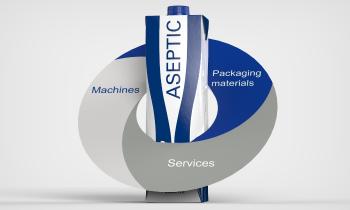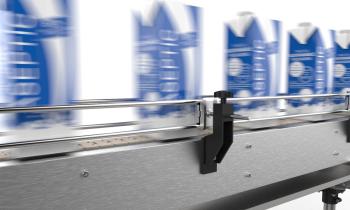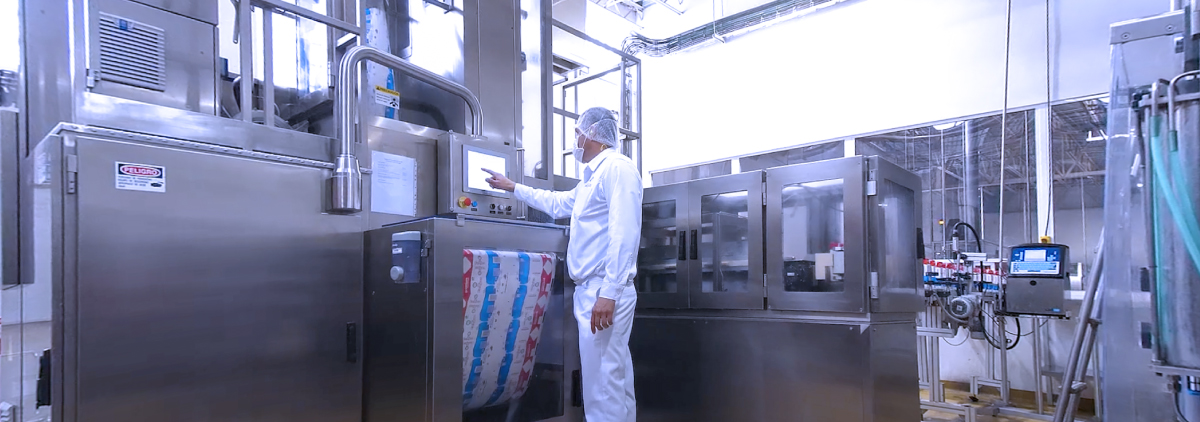Aseptic carton packaging: a deep dive
The aseptic carton packaging market
The aseptic packaging market is estimated to grow at a CAGR of 10.89%, from $39.6 billion in 2017 to $66.5 billion by 2022. The growth is mainly driven by the rapid expansion of end-use industries such as food & beverage and pharmaceuticals across China, India, Brazil and South Africa. Primary factors pushing the field upwards are the rising demand for convenience and quality products, a change in consumer lifestyle, the growth of the dairy beverage market, and last but not least, a steady increase in purchasing power in the Asia-Pacific region, which in 2019 accounted for the largest market share - 53.61%. Indeed, progress in developing countries inflates the demand for packaged food & beverages as well as natural products such as flavoured milk and juices.
As of today, the main segment is food and dairy, with a 57% share. Consumption-wise, cartons are the most common packaging material in the aseptic beverage market (51% share) as well as in the entire sector of aseptically-packaged products (72% share).
Operating principles and some historical background
Aseptic packaging consists in the process of aseptically packing food & beverage and pharmaceutical products right after sterilisation, executed through UHT (Ultra High Temperature). This is different from the standard process, where sterilisation is performed after packaging rather than before.
In addition to sterilisation, another factor that significantly impacts shelf life is the material in use. In this regard, the most common one is polylaminate, also known as multilayer aseptic carton. Polylaminate is crucial, as it decreases the exchange of oxygen with the environment while also working as a barrier against light - two elements that, if they both came into contact with the product, might negatively alter it.
Aseptic packaging was invented in the late 1920s[1], but soon discarded due to high costs and inflexibility. The technology, simply, was not mature enough. During the following decades, though, development was tremendous, leading to consumer-size aseptic packages becoming ubiquitous in the 1960s across the milk industry in Europe. As a matter of fact, Europe did not have the commercial refrigeration capacity to transport milk from rural dairies to the urban centers. The solution came in the form of carton bricks, so named because of the peculiar shape resembling a building brick.
Carton bricks guarantee several advantages over traditional milk packaging methods. For one, they do not need refrigeration, since the aseptic packaging process ensures long shelf life at ambient temperature. Also, their characteristic brick-like shape makes them easy to stack and space saving. These factors among many others determined the ballooning popularity of aseptic carton packaging, which, as of today, holds an important share in the UHT milk market.
In this white paper we are going to provide a 360-degree analysis of aseptic packaging with a particular focus on multilayer aseptic carton bricks for food & beverage products.
What multilayer aseptic carton is and how it is produced
The structure of multilayer aseptic carton for milk and beverages
In packaging, multilayer aseptic carton refers to thin multilayer structures made by combining layers of paperboard, plastic and aluminium. Multilayer aseptic carton for milk and beverages can be single portion and family size. Depending on the expected shelf life, it can have two different structures:
- 3-layer polylaminate for short shelf lives, the layers being polyethylene, paperboard, and polyethylene, it is used for pasteurised products;
- 7-layer polylaminate for longer shelf lives (i.e. up to 12 months - please note: the effective duration of the shelf life depends entirely on the liquid product). The aforementioned 7 layers are polytethylene, printing, paperboard, polyethylene, aluminium, adhesive resin, and polytethylene. The long shelf life is achieved thanks to the additional aluminium layer, today as thin as a few µm, that is inserted between the paperboard and the internal polyethylene layer.
|
LAYERS |
STRUCTURE |
|
First |
External low-density polyethylene to shelter from moisture and external agents. |
|
Second |
Printing (flexographic). Makes the packaging recognisable and appealing. |
|
Third |
Paperboard to ensure the recipient is sturdy and firm. Up to 72% of the pack is made of this layer. |
|
Fourth |
Low-density polyethylene, a lamination layer to favour adhesion between the carton and the aluminum foil. |
|
Fifth |
Aluminum foil working as a light, gas, and contamination barrier, it preserves nutritional value and the flavour of the liquid in ambient temperature. |
|
Sixth |
Adhesive resin, i.e. the ionomer located between the aluminum foil and the internal polyethylene to enhance adhesion between the two. |
|
Seventh |
Internal Polyethylene to enable alimentary use in contact with the product. |
Polyethylene, being employed in three different layers, deserves a closer look.
Polyethylene is used for moisture protection, sealing, and as a coadjuvant. Each polyethylene layer is made with a different kind of resin:
- The external layer made of Low Density Polyethylene (LDPE) protects the second layer (printing), provides moisture, and ensures functional stability to the flaps of the brick. In this layer an innovative, non-standard practice that a few players, including IPI, employ is to use biopolymers derived from sugarcane, the use of which increases the vegetable and renewable component of the packaging solution.
- The middle layer consists of an adhesive resin that makes the aluminium foil stick to the paperboard.
- The internal layer made of Linear Low Density Polyethylene (LLDPE) provides sealing as well as mechanical properties.
How multilayer aseptic carton is produced
The first phase consists of printing the paperboard, which in some cases is also creased and/or perforated. The process can take place through flexographic printing, which employs water-based inks. Afterwards, the polylaminate is produced by attaching different layers. Adhesion is accomplished by combining three methods:
-
Rolling, i.e. by connecting two different layers through an adhesive.
-
Coating, which consists of applying one or more thin layers simultaneously (coextrusion) on a single layer in order to improve the physical-mechanical characteristics or provide new ones.
Among these, extrusion is the most common technique for the production of polymer films. The parent reel, once printed and extruded with polymers and aluminium, is successively cut to obtain “children” reels. In this phase, any process defects derived from printing or extrusion are removed. Afterwards, the “children” reels are palletised and then shipped to the customer.
The advantages of multilayer aseptic carton
Multilayer aseptic carton delivers many advantages from a business, consumer, and marketing perspective.
Business-wise:
-
It ensures a long shelf life at ambient temperature.
-
Contrary to in-container sterilisation, it maintains the food nutritional and sensory properties.
-
It is space saving, and therefore more cost-efficient in terms of storage space.
-
It is more energy-efficient to produce.
-
The package can be formed simultaneously with filling through a single form-fill-seal process.
-
It protects the product from contamination.
Consumer-wise:
-
It offers the highest degree of protection.
-
It is light, easy to baggage, and safe.
-
It is easy to stow and to stack.
-
Disposal is a non-issue, since a multilayer aseptic carton is foldable.
-
It provides a large area that can be exploited for marketing information and branding.
-
Last but not least, it has a distinctive “eco-friendly” feeling.
Marketing-wise:
-
It provides a large area for graphics that can be exploited for branding.
-
The brick’s shape can be irregular, so as to perfectly fit the brand identity.
-
It is eco-sustainable, and sustainability sells.
The process of sterilisation and aseptic packaging for food & beverage

Aseptic packaging is accomplished by following these steps:
-
The liquid food product goes through a process of thermal treatment, which leads to a commercially sterile product.
-
The packaging material is sterilised in a dedicated zone inside the packaging machine.
-
At the start of every production cycle, the packaging machine itself is sterilised and kept in sterile conditions during the whole production, ensuring that the environment is completely sterile during the entire packaging process. This way, the sterilised product and the sterilised packaging material come together in a sterile environment. The result is a hermetically-sealed long-life packaged product.
Thermal treatment
Thermal treatment is used to eliminate or reduce the microbiological activity as well as to inactivate or slow down the chemical changes caused by enzyme activities into the food product.
It is obtained via a thermal shock, i.e. through heating and subsequent cooling at ambient temperature. Temperature and exposure time depend on the kind of product to be packaged and result in a different shelf life. The main sterilisation methods for liquid foods are:
-
Extended Shelf Life: the treatment of milk is intermediate between pasteurisation and UHT. It can be achieved by combining two methodologies, such as pasteurisation and microfiltration.
-
Ultra High Temperature sterilisation: this method ensures a shelf life up to 12 months depending on the liquid product undergoing the process. It varies depending on the acidity of the product to be sterilised:
-
For high-acidity products, i.e. products with a pH lower than 4.6, such as fruit, wine, and tomato, the method in use is HTST, that is, High Temperature for a Short Time. This method consists of an exposure time between 10 and 13 seconds at high temperature (90 to 105° C).
-
For low-acidity products, i.e. products with pH equal or higher than 4.6, such as milk and dairy products, the method in use is UHT. This process involves a continuous flow of heat at a high temperature, i.e. no less than 135 °C in combination with a suitable holding time between 2 and 8 seconds.
-
UHT is sufficient to ensure that the products remain microbiologically stable after incubating for 15 days at 30°C in closed containers, or for 7 days at 55 °C in closed containers.
UHT processing can be either indirect or direct.
Indirect UHT processing takes place through heat exchangers similar to those used in pasteurisation. It is performed by plate or tubular heat exchangers. Heat transfer occurs by contact of the milk with the metal surface, which is heated on the other side by steam or superheated water.
In the direct system, the liquid is treated by making direct contact with heating fluid or steam. The condensed vapour is then removed through evaporation during the passage of the product under vacuum chambers. In direct systems, superheated steam is “injected” into a stream of milk. In alternative, milk is sprayed into or allowed to fall, either as a thin film or fine streaming, through superheated steam in an infusion chamber. The two systems are known as steam injection and steam infusion.
Maintaining a sterile environment inside the packaging machine, plus sterilisation of packaging material
The aseptic packaging machine is sterilised before production and maintained sterile during the whole process through overpressure of sterile air.
Sterilisation of multilayer packaging material
The packaging material is sterilised inside the aseptic filling machine through contact with hydrogen peroxide, which is then removed through a successive drying phase. The brick is hermetically sealed inside the packaging machine - a completely sterile environment. It is important to notice that after the drying up of hydrogen peroxide, the brick is hermetically sealed inside the very same sterile environment, that is the packaging machine.
The final result is polylaminate, i.e. a multilayer aseptic carton with the characteristic aseptic brick shape.
In conclusion, multilayer aseptic carton comes with several advantages over other kinds of packaging solutions. Since every element - product, packaging material, and packaging machine - is sterilised, and since sterilisation is maintained through all stages of the packaging process, multilayer aseptic carton ensures long shelf life at the highest degree of protection at ambient temperature. Also, because of its peculiar brick-like shape, it is space saving as well as easy to stow, to baggage, and to dispose of. Finally, it is more cost-efficient and, last but not least, truly eco-sustainable.
If you want to know more about the advantages of aseptic packaging and how it can serve your business, let us know. We will be happy to find, together with you, the solution that suits you best.
[1] Source:North Carolina State University
 ASEPTIC SOLUTIONS PROVIDER
ASEPTIC SOLUTIONS PROVIDER
 FILLING EQUIPMENT
FILLING EQUIPMENT
